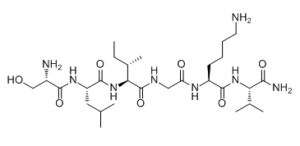Protease-Activated Receptor-2, amide (SLIGKV-NH2)
This product is for research use only, not for human use. We do not sell to patients.

For small sizes, please check our retail website as below: www.invivochem.com
| Size | Price | Stock |
|---|---|---|
| 50mg | $450 | Check With Us |
| 100mg | $750 | Check With Us |
| 200mg | $1125 | Check With Us |
Cat #: V32060 CAS #: 190383-13-2 Purity ≥ 99%
Description: Protease-Activated Receptor-2, amide (peptide sequence shortening: SLIGKV-NH2), an activating peptide of PAR2, is a novel, highly potent and selective agonist of protease-activated receptor-2 (PAR2) (Ki = 9.64 μM; IC50 = 10.4 μM).
Top Publications Citing Invivochem Products
Publications Citing InvivoChem Products
Product Promise

- Physicochemical and Storage Information
- Protocol
- Related Biological Data
- Stock Solution Preparation
- Quality Control Documentation
| Molecular Weight (MW) | 614.78 |
|---|---|
| Molecular Formula | C28H54N8O7 |
| CAS No. | 190383-13-2 |
| Protocol | In Vitro | The PAR2-activating peptides used are: SLIGKV-OH, SLIGRL-OH, SLIGKV-NH2, SLIGRL-NH2. The synthetic agonist peptides mimicking the tethered ligand of PAR2, Ser-Leu-Ile-Gly-Lys-Val (SLIGKV-OH), Ser-Leu-Ile-Gly-Arg-Leu (SLIGRL-OH) and their amidated forms Ser-Leu-Ile-Gly-Lys-Val-amide (SLIGKV-NH2) Ser-Leu-Ile-Gly-Arg-Leu-amide (SLIGRL-NH2) have also been demonstrated being able to activate the receptor without enzymatic cleavage, therefore, have been utilised as biological tools to examine physiological functions of PAR2. Protease-Activated Receptor-2, amide is one of a four family subgroup of G-protein-coupled receptors (GPCRs), called PARs. Protease-activated receptors are distinguished from other GPCRs through their unique proteolytic mechanism of activation. For PAR2, activating proteases, such as trypsin, tryptase and coagulation factors VIIa and Xa, cleave a specific extracellular amino-terminal domain of the receptor to reveal a "tethered ligand", SLIGKV- and SLIGRL- for human and mouse/rat PAR2, respectively, which subsequently interacts with the activation domain of the receptor, initiating intracellular signaling pathways |
|---|
These protocols are for reference only. InvivoChem does not
independently validate these methods.
| Solvent volume to be added | Mass (the weight of a compound) | |||
|---|---|---|---|---|
| Mother liquor concentration | 1mg | 5mg | 10mg | 20mg |
| 1mM | 1.6266 mL | 8.1330 mL | 16.2660 mL | 32.5320 mL |
| 5mM | 0.3253 mL | 1.6266 mL | 3.2532 mL | 6.5064 mL |
| 10mM | 0.1627 mL | 0.8133 mL | 1.6266 mL | 3.2532 mL |
| 20mM | 0.0813 mL | 0.4066 mL | 0.8133 mL | 1.6266 mL |
The molarity calculator equation
Mass(g) = Concentration(mol/L) × Volume(L) × Molecular Weight(g/mol)
Mass
=
Concentration
×
Volume
×
Molecular Weight*
The dilution calculator equation
Concentration(start)
×
Volume(start)
=
Concentration(final)
×
Volume(final)
This equation is commonly abbreviated as: C1 V1 = C2 V2
Concentration(start)
C1
×
Volume(start)
V1
=
Concentration(final)
C2
×
Volume(final)
V2
Step One: Enter information below
Dosage mg/kg
Average weight of animals g
Dosing volume per animal µL
Number of animals
Step Two: Enter the in vivo formulation
%DMSO
+
%
+
%Tween 80
+
%ddH2O
Calculation Results:
Working concentration:
mg/ml;
Method for preparing DMSO master liquid:
mg
drug pre-dissolved in
µL
DMSO(Master liquid concentration
mg/mL)
,Please contact us first if the concentration exceeds the DMSO solubility of the batch of drug.
Method for preparing in vivo formulation:
Take
µL
DMSO master liquid, next add
µL
PEG300, mix and clarify, next add
µL
Tween 80,mix and clarify, next add
µL
ddH2O,mix and clarify.
Note:
- (1) Please be sure that the solution is clear before the addition of next solvent. Dissolution methods like vortex, ultrasound or warming and heat may be used to aid dissolving.
- (2) Be sure to add the solvent(s) in order.




































